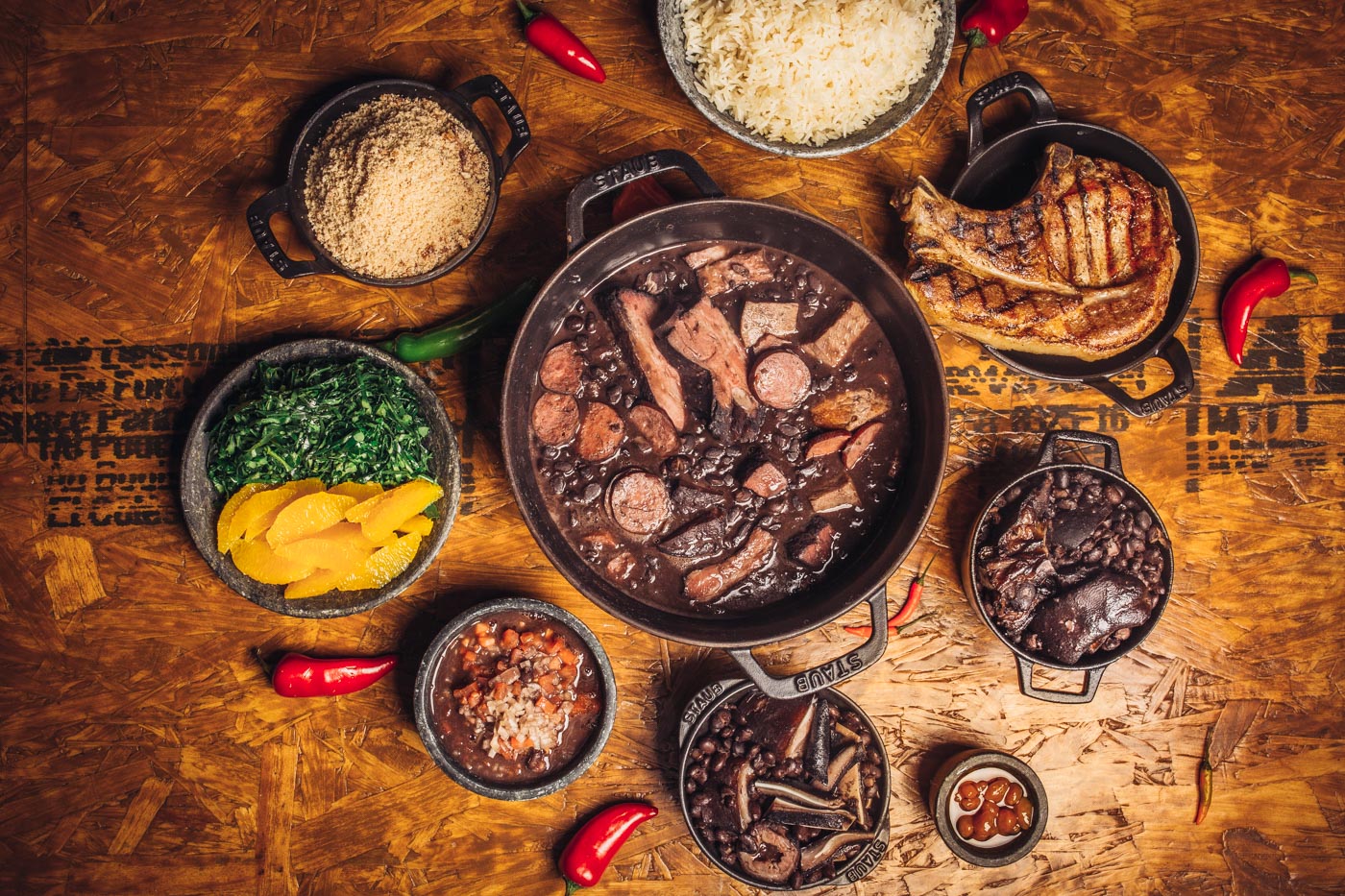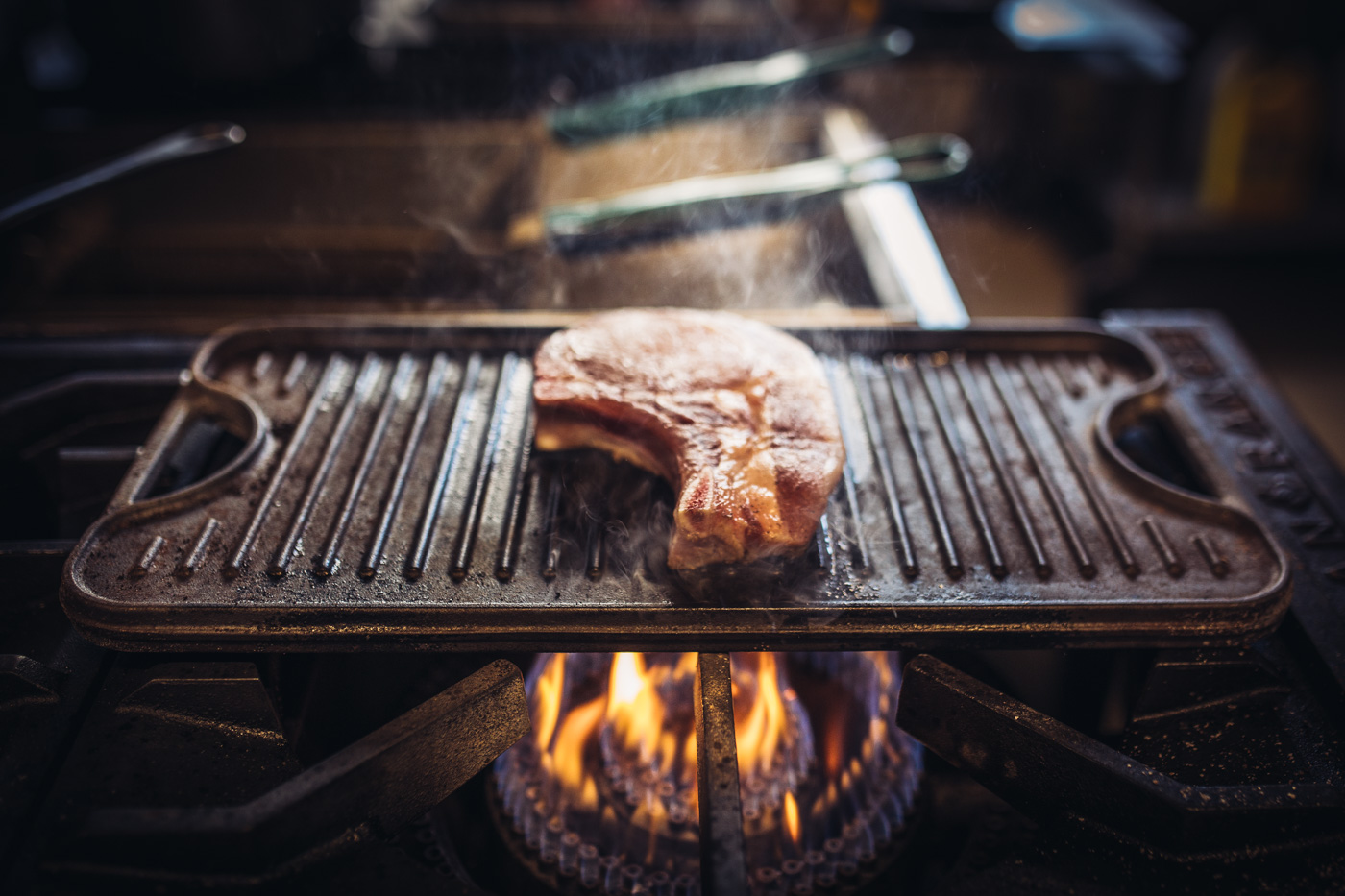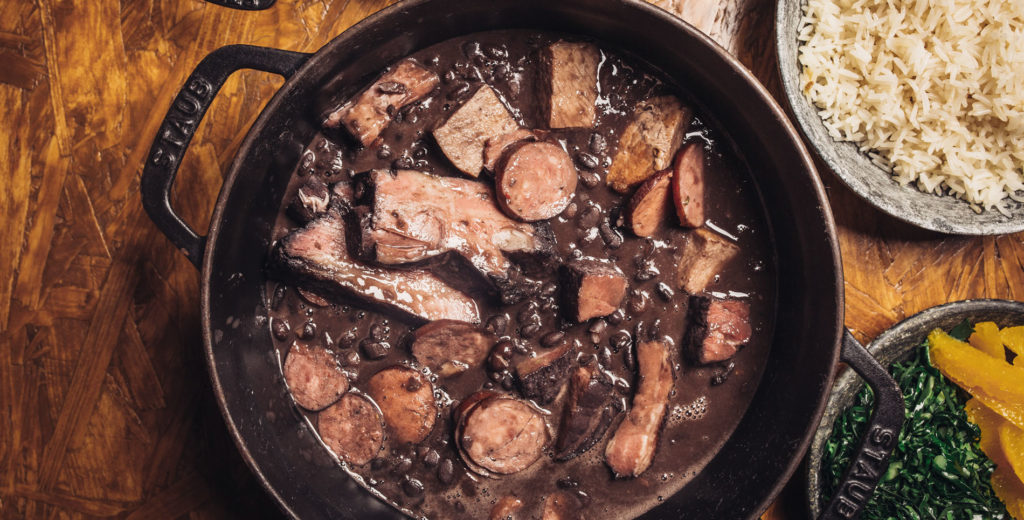What Feijoada Teaches Us About Racial Inequity in Brazil
Racial relations in Brazil can be understood through feijoada, a national gastronomy symbol, and Afrofuturism, a decolonising tool for Black Brazilians.

Pictured above: feijoada by Chef Victor Vasconcellos of Paulista Deli in Los Angeles. Find the recipe here.
In oral history, the Brazilian feijoada was created by African slaves. In literature, it is exalted as an adaptation of European culture. The country’s racial relations are revealed through this Brazilian symbol of gastronomy.
Imagine you are in Brazil, at lunchtime during the weekend. Amidst many smells and flavors, a mystical combination of various ingredients and spices intrigues you. The pleasing scent is challenging you to discover and taste. This rich, juicy, smoky combination of black beans and meat is Brazilian feijoada.
In this black bean stew, which is traditionally served in a clay bowl, the beans are steamed with beef jerky and salted pork. In a complete feijoada, the rice, farofa (cassava crumbs), and kale are served as side dishes along with a special spicy sauce made from the steamed beans and a mixture of chilli peppers.
While feijoada is not cooked and served the same way in all regions, pinto beans are used in the country’s Northeast. Because of the dish’s reputation of being a heavy food, orange is typically served on the plate to eat after. It is commonly said this fruit helps with digestion.
Feijoada’s origins date back to the era of slavery and colonialism in Brazil, the last country in the world to abolish slavery. Starting in the sixteenth century, it ended hundreds of years later on May 13, 1888. During this time, an estimated 4.9 million enslaved Africans were brought to Brazil. Today, the Black population makes up 54% of the nation’s total population—the most prominent Black population outside of Africa.
Feijoada is a culinary mixture of cultures rooted in the senzalas (slave camps) with Indigenous ingredients. The most known story of the Brazilian feijoada says African slaves used a mixture of cassava flour and water as their primary food source. They gathered the leftover pork the Portuguese slave masters discarded, such as the legs, tail and nose, and cooked it together with black beans.



The beans, originally from Central America, were consumed by the Guaraní, especially black beans along with cassava flour. Cassava is one of the most ancient foods cultivated in South America. In the book, Farinha, Feijão e Carne-Seca (Flour, Beans and Beef Jerky), Paula Pinto e Silva uses travelers’ tales to defend the thesis that boiled beans, served with flour and dried meat, was the food base for the entire population during colonial Brazil. “Both the farmers and their slaves ate the same food in the same way,” reported Alexander Philipp Maximilian zu Wied-Neuwied, a German prince traveling around Brazil during 1815 to 1817.
The first mention of the Brazilian feijoada dates back to the beginning of the nineteenth century in an advertisement published in the Diário de Pernambuco in Recife on March 2, 1827, which says, “excellent Brazilian feijoada all for a comfortable price” would be served at the Locanda da Águia d’Ouro on Thursdays.
In the available literature about food in Brazil, it seems there is an effort to find a European origin to Brazilian feijoada. Luís da Câmara Cascudo (1898-1986) is one of the most well-known historians and anthropologists, and is recognized as a central researcher of Brazilian culture and food. He is the author of the book História da Alimentação no Brasil (History of Food in Brazil), where he stated, “What we call ‘feijoada’ is a European solution elaborated in Brazil.”
Cascudo affirmed feijoada also has origins in European food preparations, dating back to the Roman Empire, comparing Brazilian feijoada with France’s cassoulet, Portuguese feijoada, and Italy’s cassoeula lombarda, because of their technical similarity in recipe.
“The most important thing about the origins of feijoada is not the investigation on the historicity or veracity of if it was created by African slaves or not. The point is the erasure of the Africans’ legacy, the effort made to destitute the Black culture of the power over the creation of food that is symbolic to all the country,” says Andressa Cabral, chef and owner of the Gastrobar Meza in Rio de Janeiro. She is also a lecturer in Creative Design in Gastronomy at Univeritas, as well as a trailblazer in using design-thinking methodology in gastronomy.
Cabral explains Brazilian cuisine began with Black people—Black women in particular. In colonial Brazil, Black women were the cooks in the kitchens of Portuguese slave masters and were also food street vendors. But, unfortunately, when gastronomy becomes intellectualized and studied in academia, its story is white-washed.
“This is part of the process of the construction of the Brazilian racist society, historically. This is not only in gastronomy,” explains Cabral. “We deny the power of intellectuality when this brain is Black. We are used to understanding Blackness at the most diverse levels of subservience.”
For centuries, colonialism and the various expressions of racism oppressed Black and Indigenous communities in Brazil. In the paper “Race Relations in Brazil: Coloniality, Dependency and Diaspora,” Leonardo Ortegal provides a critical reflection around this, stating, “the consequences of racism are not limited to economic issues. It is a form of violence that attacks the individual in his subjective as well. It eliminates the history of people and generates institutionalised processes, even indirectly, but extremely effectively.”
The Black rights movement in Brazil has developed various strategies in Black people’s struggle to overcome prejudice and racial discrimination, which marginalize these communities in the labor market, the educational and health systems, politics, society and culture as a whole. This movement was also responsible for denouncing the many ways cultural manifestations with African origins, such as Capoeira and Candomblé, were erased and criminalized in Brazilian history and society.
“Whiteness has the power of veto,” says Cabral. “And when the subject is intellectuality, power, the sovereignty of a Black group, of an Afrocentric history—this is erased. It is put aside. The highlights [of achievements] cannot be Black.”
For the majority of Brazilians, feijoada is a national symbol; it’s an acclaimed, authentic Brazilian creation. “It is a food that even those who have never experienced it will miss,” says Cabral. Feijoada is portrayed and revered through the lens of Brazilian artists and musicians, such as Chico Buarque’s song “Feijoada Completa,” or Vinicius de Morais’ poem, “Feijoada À Minha Moda.” The food even received the status as official Brazilian cultural heritage by the National Historic and Artistic Heritage Institute in 2013.
The concept of feijoada as a national symbol resulted from the Modernists’ efforts to build a Brazilian national identity in the first half of the twentieth century. In that period, the literature and arts reproduced the myth of racial democracy and a pacifistic coexistence between races. In this context, Brazilian feijoada emerged as a national dish.
Sociologist Carlos Alberto Doria, one of the thinkers on cooking and gastronomy in Brazil today and author of A Formação da Culinária Brasileira (The Formation of Brazilian Cuisine), says during an interview that there is a kind of “appeasing myth” around this dish. “In the measure in which feijoada expresses the integration of races, it erases from history that Blacks were slaves and that Indians were massacred,” he says. “Hence the expression and the great attachment of the state and tourism to this mythology.”
Today, there are people in various areas from epistemology, culture and gastronomy looking to reconnect with the country’s African and Indigenous ancestries. However, a considerable part of Brazil’s African heritage persists through oral history. When she was a student, Cabral explains, it was challenging to find historical information on Black gastronomy. Even still, it’s difficult to find information about this topic while teaching her students as there is no standard curriculum available.
The legacy of colonialism created disproportionate inequities and other complex social problems throughout Brazil, and challenging racial inequities that persist today. According to U.N., a young Black person, age fifteen to twenty-nine, dies every twenty-three minutes in Brazil. The possibility of young Black men being murdered in Brazil is 2.88 times greater than that of young white men. Latin America has one of the highest femicide rates globally, and in Brazil, especially during the pandemic, a woman is victim of this type of crime every nine hours. Black women are the most affected.
Andressa Cabral sees Afrofuturism as a glimpse of hope in reclaiming a narrative and future for Black Brazilians—for their stories and their lives.
“Based on the current statistics of the Black population in Brazil, our future is horrible, is obscure, and I don’t want this future for me. Redesigning the future outlook is fundamental,” Cabral explains. “Afrofuturism is an opportunity for a dreamlike, idyllic place of success, reunion and fraternity.”
Afrofuturism, a cultural movement that initially explored the intersections of the African diaspora with technology and science fiction, is now a source of inspiration for Black people in creative industries, literature, politics, philosophy and gastronomy. Artist and activist Ingrid LaFleur, a prominent name in this movement, states in an interview, “Afrofuturism offers a beautiful, almost entertaining, seductive approach to think about the decolonial process.”
Cabral finds Afrofuturism as a way to fill that historical gap, as well as the absence of Black narratives in Brazilian History. And most notably, she sees it as a lifestyle and way to define the cuisine she produces. “Today, I make a gastronomy that lies in the lap of ancestry, in an extremely conscious way,” she explains. “Afrofuturism … is the movement that represents me today because it forces us, obviously, to look at the past; because you can’t project a future without knowing where you come from and who you are.”







Our comments section is for members only.
Join today to gain exclusive access.